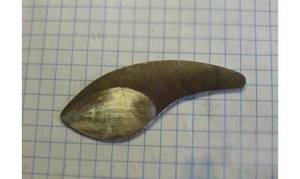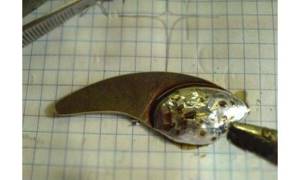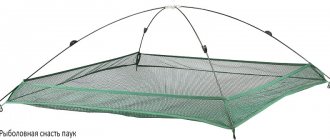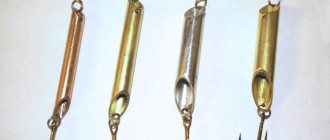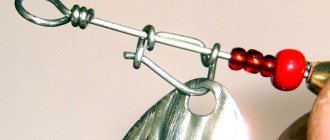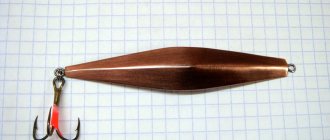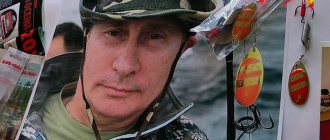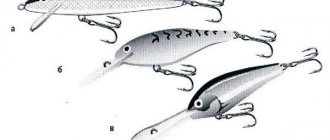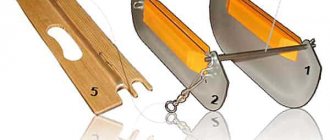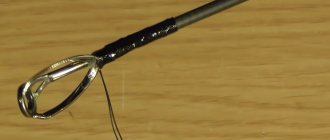What type of spinner
This lure was invented by Vladimir Matveychikov, a famous Russian fisherman. Matveychikov's spinner is a bait for catching predatory fish from the ice. Its main purpose is to catch perch, although if desired, you can also catch other predators that live in our reservoirs.
According to the type of game, Matveychikov's spinner belongs to the falling spinners . Due to its unique play, Matveychikov’s spinner has excellent catchability. Classic Matveychikov spinners are used for fishing in still water at depths from 1.5 to 5 meters.
DIY spinner spinner
Loading …
Let's imagine design options that will be easy to make even for an inexperienced fisherman. The procedure includes the following steps:
- A petal-shaped blank is cut out of sheet metal. A hole is drilled in it for the location of the clamp.
- Using a bearing ball, the workpiece is given a curved shape.
- Now the metal surface is polished using a special attachment for a drill or screwdriver.
- The diamond edge version is manufactured using the same bearing ball. The workpiece is placed on top and struck with a hammer. Each hit creates one edge.
- Pre-purchased clamps and beads are placed on the wire.
- A pinwheel can be made using copper wire, which is tightly wound onto a thicker rod. One end of the pinwheel is sharpened on an emery wheel until it is shaped into a cone.
- As a result, a wire is hooked onto the hook, onto which a pinwheel, multi-colored beads, and a petal blank are sequentially put on.

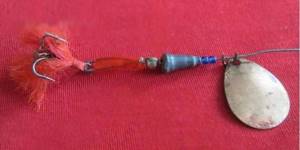
Appearance
There are two types of Matveychikov spinners - with a single soldered
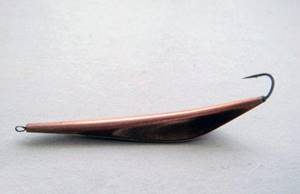
and a hanging treble hook.
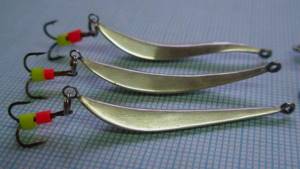
The latter are used for catching passive perch.
The classic Matveychikov spinner has a length of 40 mm, a width of 10 mm, an extension at the back and a characteristic bend, which ensures an original game. But since domestic fishermen are inclined to experiment, they make their own baits ranging in size from 25 to 100 mm while maintaining the original proportions, which can be used for fishing at different depths.
One side of the Matveychikov spinner is made of non-ferrous metal or alloy: copper, brass, cupronickel, beryllium bronze, the second is made of solder, although bimetallic spinners are also found.
Expert opinion
Knipovich Nikolai Mikhailovich
Zoologist, hydrobiologist. I am interested in fishing at a professional level.
Attention! The tee should be equipped with a bright epoxy resin drop. It is the “attack point” for the predator.
DIY bullet weight
There are two ways to make a bullet weight for Texas yourself. The brass weight will have to be sharpened or use the services of a familiar turner. Lead can be cast at home, and this does not require any special costs or skills.
The mold is made of plaster and consists of two halves. Before pouring molten lead, it is necessary to place a steel wire lubricated with fat or oil into it for subsequent removal. After drying, the load remains to be modified with a file, removing excess burrs and flaws.
Advantages and disadvantages
The bait has the following advantages:
- high catchability;
- ease of making with your own hands;
- low cost of store-bought spinners;
- high fishing speed with a bait with a soldered hook, since the fish can be quickly unhooked;
- possibility of using different types of wiring.
At the same time, it is not without some disadvantages, the main of which are:
- the need to use a fishing line of a certain diameter to give the bait the necessary game;
- the need to fish without a fastener, since the use of the latter negatively affects the performance of the spinner;
- impossibility of fishing in strong currents.
Store options
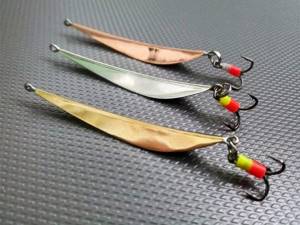
Those fishermen who are not inclined to be creative on their own can purchase Matveychikov’s lure in fishing stores, especially since this bait is very inexpensive. The most famous manufacturers of this bait are the following:
- GOA Company. There is a wide range of spinners, including lures with single and treble hooks and different materials used in the production of the spinner.
- Samovar and Co. Classic spinners are produced with a length of 40 mm and a weight of 2.5 grams, equipped with a Mustad tee. The crown can be made of copper, cupronickel, copper, brass. Upon request, an angler can purchase a silver-plated spinner.
- R.B. The Optima brand produces spinners weighing from 2 to 6 grams, equipped with tees.
The cost of store-bought spinners does not exceed 300 rubles. The fisherman must decide for himself what type of fishing is his priority and choose the right lure. Beginner fishermen can be advised to use heavier baits with a hanging tee, since the fishing technique with them is simpler, and a moving tee will provide better results.
How to make a universal spinner with your own hands
The option, which can be used in any conditions, is called “Torpedka”. The bait is capable of diving strictly vertically under water and playing with minimal movements.
![DIY spinner for fishing - instructions with pictures [2019]](https://korabel29.ru/wp-content/uploads/blesna-svoimi-rukami-dlya-rybalki-instrukciya-s-kartinkami-2019.jpg)
For manufacturing you will need the following materials:
- sheet metal, preferably stainless steel;
- small diameter wire (should not rust) or guitar string;
- swivels (2 pcs);
- paste GOI;
- winding rings.
When everything is ready, you can start production. It includes the following steps:
- Creating a template and transferring it to a sheet of metal. It is recommended to first draw the template on cardboard and then trace it onto the aluminum. You need to cut carefully to avoid the appearance of sharp jagged edges. The simplest form you can use is a tablespoon.
- Folding the workpiece in half. You should end up with two identical parts arranged symmetrically.
- Processing irregularities with sandpaper or a file.
- Soldering a fastener consisting of two swivels connected with wire. In order for the solder to stick to the aluminum better, the latter needs to be sanded with coarse sandpaper.
- The workpiece is filled with solder. After hardening, it is polished with GOI paste. If desired, one of the sides can be painted in the color of copper or gold.

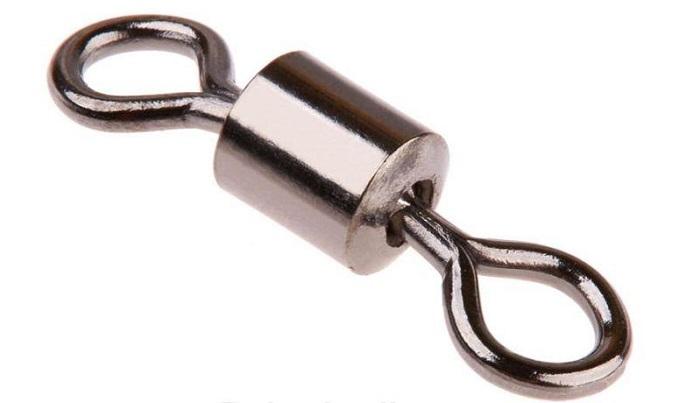
This completes the main part of the production. All that remains is to hang the treble hook on a loop and decorate it with multi-colored cambrics to attract the attention of the fish.
DIY making
To make a Matveychikov spinner you will need the following:
Drawing
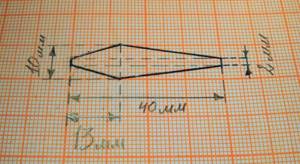
The drawing must be prepared in advance. It is more convenient to do it on graph paper. Typically, various fishing sites offer drawings of a classic spoon 40 mm long and 10 mm wide. If you need to make a bait of a larger or smaller size, then all proportions must be observed.
Materials
- sheet metal 0.5 mm thick. It can be purchased in specialized stores, markets or ordered in online stores;
- solder, which is purchased in the same way;
- phosphoric acid for soldering;
- paste GOI;
- triple or single hook;
- winding ring;
- a pin or thin steel wire for making rings to which a fishing line is tied or a tee is attached.
Tools
- metal scissors;
- soldering iron;
- file;
- needle files;
- sandpaper;
- wire cutters;
- round nose pliers.
Step by step process
- They make a drawing.
- A piece 40 mm long and 10 mm wide is cut out.
- A longitudinal straight line is drawn on the workpiece with a sharp object.
- Measure 13 mm from one edge and draw a transverse line.
- All excess is cut off.
- The workpiece is bent in the longitudinal direction at an angle of 90 degrees.
- File all the corners, making them more rounded.
- Bend the workpiece, giving it a crescent shape.
- If a single hook is used, then the eye is cut off and the fore-end is soldered from the inside to the wide side of the workpiece. If a tee is used, a loop is soldered, which is made from a pin or wire.
- In a similar way, solder the ring to the narrow part of the workpiece.
- Apply solder to the inside of the workpiece;
- The workpiece is processed with a file and polished.
- Attach a tee, if provided.
Self-production
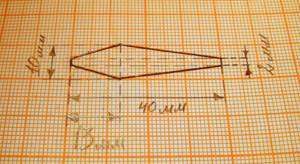
It’s quite possible to do it yourself. Here we will look at making a spinner weighing three grams. First, let's look at its drawing.
As we can see, the form is quite simple and does not seem to raise any questions
We list the materials that we will need in the manufacturing process:
- Copper sheet half a millimeter thick. Its dimensions should be sufficient to cut a part two centimeters wide and four meters long.
- The hook we are using here is Owner no.
- A piece of thin steel wire two centimeters long or the eye of a pin. This is necessary to make a loop to which the fishing line will be tied.
- Solder POS-40 and soldering acid. We will attach both the hook and the fastening loop to the tackle using a soldering iron.
- Sandpaper. You will also need GOI polishing paste. The fully manufactured product must be processed in this manner.
Step by step guides
Now we will describe in detail each step of making the Matveychikov spinner:
First you need to prepare a copper sheet for work.
Fishing tactics and playing technique
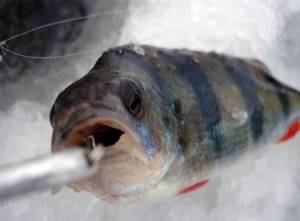
The tactics for fishing with Matveychikov’s lure are the same as when fishing with other winter lures and balancers. The main task is to find a perch or other predator. Since this bait was originally a sports spinner, and athletes, as a rule, have to catch small perch in lakes, a search is underway for places with the maximum concentration of this predator.
In the arsenal of an athlete, there are usually several pre-set fishing rods with fishing line of different thicknesses, designed for fishing at different depths and with baits of different sizes. It is better to look for fish with a spoon equipped with a treble hook. Once you get to a hole where the perch bites more or less consistently, you should switch to fishing with a spoon with a single bait, which will significantly speed up the fishing process. You can fish even faster with a lure with a barbless hook, simply throwing the caught fish off the hook with a movement of your hand.
It is important not only to find the perch, but also to keep it under the hole , and, if possible, raise it as high as possible from the bottom. An essential point in achieving the desired result, namely victory in competitions, is the search for places with larger fish.
For an amateur, it is important not only the quantity, but also the quality of the fish caught. Therefore, you should look for perch schools in which the average fish size is higher. The tactics for searching for perch in an unfamiliar body of water is to gradually move from the shore into the depths. If there are people gathering on the ice for hobby reasons, you should carefully monitor their movements and, if something happens, join the “crowd”, while adhering to the rules of fishing ethics.
Expert opinion
Knipovich Nikolai Mikhailovich
Zoologist, hydrobiologist. I am interested in fishing at a professional level.
Important! When fishing in many bodies of water, especially large ones, perch can stay not only near the bottom, but also in half-water. Therefore, you should fish different water horizons under the ice.
Matveychikov’s lure fishing technique looks like this:
- The bait is lowered to the bottom and hit it several times, creating a noise effect and a cloud of turbidity that attracts a predator.
- Make a sharp (sometimes smooth) rise with the tip of the fishing rod 30-50 cm from the bottom and, after a short pause, reset to the starting position.
- Be sure to pause at the lowest point, the duration of which depends on various factors, primarily on the activity of the predator.
- Repeat the cycle several times.
- They fish the horizon higher than the previous one.
- If there are no bites, they move to another place.
- If any activity of a predator is observed (tosses, pokes), but it is not possible to catch it, they try to change the game, and if this does not help, they change the bait.
Homemade “Kastmater” from a copper tube
Without any problems, you can make winter lures for perch with your own hands from a copper tube. If everything is done correctly, they will work no worse than the same.
After practice, we’ll try to make more complex winter lures for perch with our own hands. We make drawings of the future bait on paper in advance. Matveychikova spinner - duration: 2:07. Igor spinner with his own hands in 5 minutes. We draw a figure in the form of an elongated drop 30-40 mm long. The width of the “torpedo” in the upper part is 10 mm, in the lower part – 3 mm. Next we make a pattern out of paper, cutting out our sketch.
Now you need to prepare materials and tools. We will need:
- sheet copper 0.5 mm wide;
- awl;
- metal scissors;
- soldering iron, acid and solder;
- hammer;
- a striker with a rounded striking surface or a set of iron balls;
- thick rubber;
- a piece of copper wire with a cross section of 0.5-0.6 mm;
- hook No. 4-6 (single);
- ratfil;
- sandpaper.
We suggest you familiarize yourself with: Fishing Rod for Crucian Carp in the Reeds || Fishing Rod for Crucian Carp in the Reeds
We transfer the sketch to a sheet of copper and cut out two similar blanks. Each of them needs to be given a convex shape over the entire surface. To do this, we lay the workpiece on thick rubber, using a striker or an iron ball of the required size and a hammer to give the surface unevenness.
Next, the inside of each workpiece must be treated with acid and covered with a layer of solder. You need to make two small loops from copper wire to attach the winding rings, and solder them from the inside to one of the sides.
After that, the halves need to be put together and the connection line must be soldered in such a way that water does not get inside the spinner. At the end of the main work, the workpiece is painstakingly cleaned with ratfil and sanded with sandpaper until it becomes completely even and smooth.
We thread the winding rings into the holes. We attach the hook to the wide side of the spoon.
Alternatives to Matveychikov's spinner
Matveychikov's spinner is not the only bait used by sports fishermen and amateurs. Many amateurs use spinners with a soldered double, but using them in competitions is prohibited. The most well-known baits that can successfully replace the Matveychikov spinner are the following:
- Maropedka. A sports spoon invented by St. Petersburg athlete Alexander Vorobyov, a multiple champion of Russia and world champion in fishing. In fact, it is a hybrid of a Matveychikov spinner, a diamond and a torpedo. Gradually, amateur fishermen mastered it, increasing its size;
- St. Petersburg sleeper. A bait that allows for variability in size, equipment with hooks and the use of one or two crowns;
- torpedo A sports spinner with a length of 45 mm and a weight of 2.5 grams. The greater the depth, the thinner the fishing line is required to provide the bait with the desired play. It is recommended to fish by making short, smooth jerks;
- Mercedes. An original bait invented by Anatoly Kovalev.
Expert opinion
Knipovich Nikolai Mikhailovich
Zoologist, hydrobiologist. I am interested in fishing at a professional level.
Interesting! Its catchability is ensured by the fact that it has a chaotic game. It is quite difficult to master fishing with such bait, but if you can achieve this, success is guaranteed.
In amateur fishing, an alternative to a spinner can be the well-known triangulars, diamonds, petals, etc.
DIY cicada spinner
To make such a spinner you will need sheet metal. Stainless steel is often used, but you can use any other that is thin (0.5-0.8 mm), light and at the same time durable. It should be mentioned that not all stainless steel is soldered. Galvanized steel works well.
|
Further making of spinners with your own hands includes the following steps:
- The workpiece is given a concave shape. To do this, take a hammer with a rounded head or a 6 mm thick matrix. If a hammer is used to give the shape, then the cut piece of metal is located at the end of the wooden beam; if it is a matrix, rubber is placed under the workpiece, and a recess is tapped on the matrix.
- The loaded part is soldered. A soldering iron with a power of 60-100 W and tin solder will do. In the case of an oxidized metal surface, only the soldering area is cleaned; this limits the area where the solder spreads. On bare metal, the borders are covered with masking tape. When soldering the second side, you must ensure that the first does not melt. You can also solder the bottom tee at this stage.
- The irregularities are cleaned up and a streamlined shape is given. Coarse sandpaper is used for painting, fine sandpaper for polishing.
- The location for attaching the carabiner is marked. It should be located strictly in the center of the top of the bait. To determine it, the spoon is taken with tweezers with sharp edges. When the first hole is drilled, 2.5 mm are retreated from it in both directions and two more similar ones are drilled. This is done so that when suspended from the front hole, the bait plays less actively, and when suspended from the back hole, it plays more actively.
